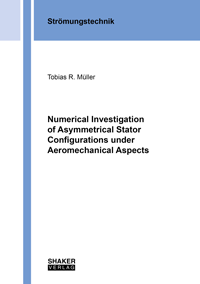
Shop : Details
Shop
Details
59,80 €ISBN 978-3-8440-9563-0Softcover282 pages79 figures365 g21 x 14,8 cmEnglishThesis
July 2024
Tobias R. Müller
Numerical Investigation of Asymmetrical Stator Configurations under Aeromechanical Aspects
The structural integrity of components is a key prerequisite to ensure a safe operation of turbomachines and to guarantee their availability. In this context, a relevant failure scenario is high cycle fatigue of the turbomachinery rotor. For its mitigation, the design objectives from an aeromechanical point of view are to reduce the aerodynamic forcing amplitude of the rotor as much as possible, while at the same time achieving to increase its damping, such that the vibratory stresses in operation remain as low as the endurance limit of the material.
Conventional stator designs are typically characterized by vanes of identical shape that are arranged equidistantly around the circumference. In contrast, asymmetrical stator configurations typify all those stator designs, whose individual vanes are not arranged equidistantly and which may exhibit an additional variation in their shaping. Their application aims to control the aerodynamic forcing characteristic of the turbomachinery rotor in a targeted manner and to particularly reduce the aerodynamic forcing amplitude of relevant frequency contributions.
This numerical study is intended to contribute to the investigation of asymmetrical stator configurations under aeromechanical aspects and addresses their influence on the aerodynamic forcing and damping characteristic of the rotor. A transonic axial turbine stage of a turbocharger, which is in series equipped with an asymmetrical stator configuration, serves as an exemplary study case. The findings of this study prove asymmetrical stator configurations in their potential to be used as a suitable design feature for passive aeroelastic control.
Conventional stator designs are typically characterized by vanes of identical shape that are arranged equidistantly around the circumference. In contrast, asymmetrical stator configurations typify all those stator designs, whose individual vanes are not arranged equidistantly and which may exhibit an additional variation in their shaping. Their application aims to control the aerodynamic forcing characteristic of the turbomachinery rotor in a targeted manner and to particularly reduce the aerodynamic forcing amplitude of relevant frequency contributions.
This numerical study is intended to contribute to the investigation of asymmetrical stator configurations under aeromechanical aspects and addresses their influence on the aerodynamic forcing and damping characteristic of the rotor. A transonic axial turbine stage of a turbocharger, which is in series equipped with an asymmetrical stator configuration, serves as an exemplary study case. The findings of this study prove asymmetrical stator configurations in their potential to be used as a suitable design feature for passive aeroelastic control.
Keywords: turbomachine; turbocharger; axial turbine; non-axisymmetric stator; asymmetrical stator; CFD; aeromechanics; low engine order (LEO); aeroelasticity; HCF; forced response; reflections; non-reflecting boundary conditions; mesh inflation; embedded flutter
Available online documents for this title
You need Adobe Reader, to view these files. Here you will find a little help and information for downloading the PDF files.
Please note that the online documents cannot be printed or edited.
Please also see further information at: Help and Information.
Please also see further information at: Help and Information.
| Document |  | Document | ||
| Type |  | |||
| Costs |  | 44,85 € | ||
| Action |  | Purchase in obligation and download the file | ||
| Document |  | Table of contents | ||
| Type |  | |||
| Costs |  | free | ||
| Action |  | Download the file | ||
User settings for registered online customers (online documents)
You can change your address details here and access documents you have already ordered.
User
Not logged in
Export of bibliographic data
Shaker Verlag GmbH
Am Langen Graben 15a
52353 Düren
Germany
Am Langen Graben 15a
52353 Düren
Germany
Mon. - Thurs. 8:00 a.m. to 4:00 p.m.
Fri. 8:00 a.m. to 3:00 p.m.
Fri. 8:00 a.m. to 3:00 p.m.
Contact us. We will be happy to help you.



